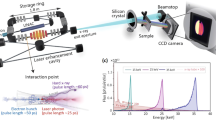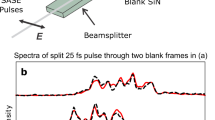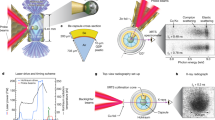Abstract
X-ray scattering is typically used as a weak linear atomic-scale probe of matter. At high intensities, such as produced at free-electron lasers, nonlinearities can become important, and the probe may no longer be considered weak. Here we report the observation of one of the most fundamental nonlinear X-ray–matter interactions: the concerted nonlinear Compton scattering of two identical hard X-ray photons producing a single higher-energy photon. The X-ray intensity reached 4 × 1020 W cm−2, corresponding to an electric field well above the atomic unit of strength and within almost four orders of magnitude of the quantum-electrodynamic critical field. We measure a signal from solid beryllium that scales quadratically in intensity, consistent with simultaneous non-resonant two-photon scattering from nearly-free electrons. The high-energy photons show an anomalously large redshift that is incompatible with a free-electron approximation for the ground-state electron distribution, suggesting an enhanced nonlinearity for scattering at large momentum transfer.
This is a preview of subscription content, access via your institution
Access options
Subscribe to this journal
Receive 12 print issues and online access
$209.00 per year
only $17.42 per issue
Buy this article
- Purchase on Springer Link
- Instant access to full article PDF
Prices may be subject to local taxes which are calculated during checkout





Similar content being viewed by others
References
James, R. W. The Optical Principles of the Diffraction of X-rays (Ox Bow Press, 1982).
Warren, B. E. X-ray Diffraction (Addison-Wesley, 1969).
Ladd, M. F. C. & Palmer, R. A. Structure Determination by X-ray Crystallography (Springer, 2003).
Compton, H. The spectrum of scattered X-rays. Phys. Rev. 22, 409–413 (1923).
Platzman, P. M. & Tzoar, N. X-ray scattering from an electron gas. Phys. Rev. 139, 410–413 (1965).
Eisenberger, P. & Platzman, P. M. Compton scattering of X rays from bound electrons. Phys. Rev. A 2, 415–423 (1970).
Young, L. et al. Femtosecond electronic response of atoms to ultra-intense X-rays. Nature 466, 56–61 (2010).
Doumy, G. et al. Nonlinear atomic response to intense ultrashort X rays. Phys. Rev. Lett. 106, 083002 (2011).
Hoener, M. et al. Ultraintense X-ray induced ionization, dissociation, and frustrated absorption in molecular nitrogen. Phys. Rev. Lett. 104, 253002 (2010).
Fang, L. et al. Double core-hole production in N2: Beating the Auger clock. Phys. Rev. Lett. 105, 083005 (2010).
Rohringer, N. et al. Atomic inner-shell X-ray laser at 1.46 nanometres pumped by an X-ray free-electron laser. Nature 481, 488–491 (2012).
Kanter, E. P. et al. Unveiling and driving hidden resonances with high-fluence, high-intensity X-ray pulses. Phys. Rev. Lett. 107, 233001 (2011).
Weninger, C. et al. Stimulated electronic X-ray Raman scattering. Phys. Rev. Lett. 111, 233902 (2013).
Tamasaku, K. Double core-hole creation by sequential attosecond photoionization. Phys. Rev. Lett. 111, 043001 (2013).
Tamasaku, K. et al. X-ray two-photon absorption competing against single and sequential multiphoton processes. Nature Photon. 8, 313–316 (2014).
Shwartz, S. et al. X-ray second harmonic generation. Phys. Rev. Lett. 112, 163901 (2014).
Eisenberger, P. & McCall, S. L. X-ray parametric conversion. Phys. Rev. Lett. 26, 684–688 (1971).
Freund, I. & Levine, B. F. Parametric conversion of X rays. Phys. Rev. Lett. 23, 854–857 (1969).
Brown, L. S. & Kibble, T. W. B. Interaction of intense laser beams with electrons. Phys. Rev. 133, A705–A719 (1964).
Chen, S.-Y., Maksimchuk, A. & Umstadter, D. Experimental observation of relativistic nonlinear Thomson scattering. Nature 396, 653–655 (1998).
Bula, C. et al. Observation of nonlinear effects in Compton scattering. Phys. Rev. Lett. 76, 3116–3119 (1996).
Glover, T. E. et al. X-ray and optical wave mixing. Nature 488, 603–608 (2012).
Huang, Z. & Kim, K.-J. Review of x-ray free-electron laser theory. Phys. Rev. Spec. Top. Accel. Beams 10, 034801 (2007).
Sauter, F. Über das Verhalten eines Elektrons im homogenen elektrischen Feld nach der relativistischen Theorie Diracs. Z. Phys. 69, 742–764 (1931).
Schwinger, J. On gauge invariance and vacuum polarization. Phys. Rev. 82, 664–679 (1951).
Boutet, S. & Williams, G. J. The Coherent X-ray Imaging (CXI) instrument at the Linac Coherent Light Source (LCLS). New J. Phys. 12, 035024 (2010).
Hubbell, J. H. & Seltzer, S. M. Tables of X-ray Mass Attenuation Coefficients and Mass Energy-Absorption Coefficients (version 1.4) (National Institute of Standards and Technology, 2004); http://physics.nist.gov/xaamdi
Herrmann, S. et al. CSPAD-140 k: A versatile detector for LCLS experiments. Nucl. Instrum. Methods Phys. Res. A 718, 550–553 (2013).
Sarachik, E. S. & Schappert, G. T. Classical theory of the scattering of intense laser radiation by free electrons. Phys. Rev. D 1, 2738–2753 (1970).
Klein, O. & Nishina, Y. Über die Streuung von Strahlung durch freie Elektronen nach der neuen relativistischen Quantendynamik von Dirac. Z. Phys. 52, 853–868 (1929).
Hämäläinen, K. et al. High resolution Compton scattering study of Be. Phys. Rev. B 54, 5453–5459 (1996).
Hopersky, A. N., Nadolinsky, A. M. & Novikov, S. A. X-ray-photon scattering by an excited atom. Phys. Rev. A 88, 032704 (2013).
Hopersky, A. N., Nadolinsky, A. M., Novikov, S. A. & Yavna, V. A. X-ray-photon scattering by an excited and ionized atom. Phys. Rev. A 91, 022708 (2015).
Henke, B.L., Gullikson, E.M. & Davis, J.C. X-ray interactions: Photoabsorption, scattering, transmission, and reflection at E = 50–30000 eV, Z = 1–92. At. Data Nucl. Data Tables 54, 181–342 (1993).
Ratner, D. et al. Second and third harmonic measurements at the linac coherent light source. Phys. Rev. Spec. Top. Accel. Beams 14, 060701 (2011).
Acknowledgements
This work was supported primarily by the US Department of Energy (DOE), Office of Basic Energy Sciences (BES) and the Volkswagen Foundation. Portions of this research were carried out at the Linac Coherent Light Source (LCLS) at the SLAC National Accelerator Laboratory. Preparatory measurements were carried out at the Stanford Synchrotron Radiation Lightsource (SSRL). Both LCLS and SSRL are Office of Science User Facilities operated for the US Department of Energy Office of Science by Stanford University. M.F. acknowledges support from the Volkswagen Foundation. M.K. was supported by the DOE Office of Science Graduate Fellowship Program. M.T. and J.C. were supported by the Division of Materials Sciences and Engineering, BES, DOE under contract 51 DE-AC02-76SF00515. D.A.R., G.N. and S.Ghimire were supported by the AMOS program within the Chemical Sciences, Geosciences, and Biosciences Division, DOE, BES, DOE. We thank R. Santra for discussions.
Author information
Authors and Affiliations
Contributions
M.F. and D.A.R. conceived and with S.B., C.K., S.Guillet and J.B.H. designed the experiment. S.H., G.A.C., J.P., P.H., C.K., S.Guillet, S.B., G.J.W. and M.M. designed and fabricated the components of the experiment. M.F., M.T., J.C., S.Ghimire, S.S., M.K., M.J., T.H., C.B., G.N., Y.F., S.H., S.M., J.B.H. and D.A.R. carried out the experiment. S.B., G.J.W., M.M. and M.M.S. operated the coherent X-ray imaging instrument. M.F., M.T. and J.C. analysed the data. M.F. and D.A.R. interpreted the results with input from P.H.B., and M.F. and D.A.R. wrote the manuscript with input from all other authors.
Corresponding author
Ethics declarations
Competing interests
The authors declare no competing financial interests.
Supplementary information
Supplementary information
Supplementary information (PDF 1623 kb)
Rights and permissions
About this article
Cite this article
Fuchs, M., Trigo, M., Chen, J. et al. Anomalous nonlinear X-ray Compton scattering. Nature Phys 11, 964–970 (2015). https://doi.org/10.1038/nphys3452
Received:
Accepted:
Published:
Issue Date:
DOI: https://doi.org/10.1038/nphys3452
This article is cited by
-
Angle-dependent interferences in electron emission accompanying stimulated Compton scattering from molecules
Communications Physics (2021)
-
Using X-ray free-electron lasers for spectroscopy of molecular catalysts and metalloenzymes
Nature Reviews Physics (2021)
-
Effect of high slice energy spread of an electron beam on the generation of isolated, terawatt, attosecond X-ray free-electron laser pulse
Scientific Reports (2020)
-
Review of fully coherent free-electron lasers
Nuclear Science and Techniques (2018)
-
Rabi oscillations of X-ray radiation between two nuclear ensembles
Nature Photonics (2017)



